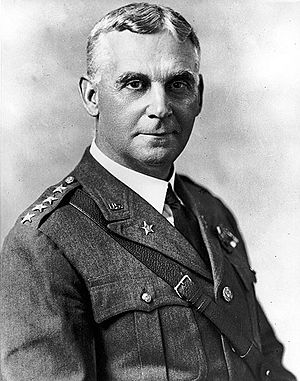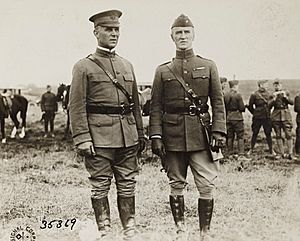Charles Pelot Summerall facts for kids
Quick facts for kids
Charles Pelot Summerall
|
|
|---|---|

General Charles P. Summerall
|
|
| Born | March 4, 1867 Blounts Ferry, Columbia County, Florida, United States |
| Died | May 14, 1955 (aged 88) Washington, D.C., United States |
| Buried | |
| Allegiance | |
| Service/ |
|
| Years of service | 1888–1931 |
| Rank | |
| Unit | Infantry Branch Field Artillery Branch |
| Commands held | Chief of Staff of the United States Army Hawaiian Department IV Corps IX Corps V Corps 1st Division 67th Field Artillery Brigade 1st Field Artillery Brigade Fort Flagler Fort William H. Seward Fort Lawton |
| Battles/wars | Spanish–American War Philippine–American War China Relief Expedition World War I |
| Awards | |
| Other work | President of The Citadel (1931–1953) |
General Charles Pelot Summerall (March 4, 1867 – May 14, 1955) was a very important U.S. Army officer. He led the 1st Infantry Division during World War I. Later, he became the Chief of Staff of the United States Army, which is the highest-ranking officer in the Army, from 1926 to 1930. After his military career, he served as the President of The Citadel, a famous military college, from 1931 to 1953.
Contents
Early Life and Education
Charles Pelot Summerall was born in Blounts Ferry, Columbia County, Florida, on March 4, 1867. He attended the Porter Military Academy in South Carolina from 1882 to 1885. After graduating, he worked as a school teacher for three years. In 1888, he joined the United States Military Academy at West Point, New York. He graduated from West Point in June 1892.
Starting His Military Career
After graduating, Summerall became a second lieutenant. He was first assigned to the 1st Infantry Regiment. In March 1893, he moved to the 5th Artillery Regiment. He served in California from 1893 to 1895. Then, he was stationed at Fort Hamilton, New York, from 1895 to 1898.
Serving in Different Wars
During the Spanish–American War, he worked as an aide and engineer officer. This was from 1898 to 1899. He was promoted to first lieutenant in March 1899. Summerall also took part in the Philippine Insurrection from 1899 to 1900. He was part of the China Relief Expedition from 1900 to 1901. During this time, he helped in the attack on Peking.
In July 1901, he became a captain. He was assigned to the 106th Coast Artillery Company. He served at Forts Walla Walla and Lawton in Washington state. He commanded Fort Lawton from 1901 to 1902. He also worked in Alaska, helping to set up Fort William H. Seward. He commanded Fort Flagler from 1902 to 1903. Later, he moved to the 3rd Field Artillery Battery. He served at Camp Thomas and Fort Myer from 1903 to 1905.
Teaching and Leadership Roles
From 1905 to 1911, Summerall was a main instructor of artillery tactics at West Point. He became a major in March 1911. He then led the field artillery of the Maneuver Division in San Antonio, Texas.
He was in charge of summer training camps for Army and National Guard artillery from 1912 to 1914. He also helped manage the Militia Bureau. He worked on buying artillery ranges. He was part of several important boards and commissions. These included the Ordnance Board and a group looking into making military supplies. In 1917, he joined a military mission to the British and French armies. He was promoted to lieutenant colonel in 1916, colonel in 1917, and brigadier general in August 1917.
World War I Service
During World War I, Summerall commanded the 67th Field Artillery Brigade. He also led the 1st Field Artillery Brigade in France in 1917. He was promoted to major general. He then commanded his brigade, the 1st Division, and V Corps. He took part in major battles in 1918. These included the Cantigny, Soissons, St. Mihiel, and Meuse-Argonne operations.
On November 9, 1918, the Allied Commander-In-Chief ordered a general attack. This attack was carried out by the First Army on November 10–11. General Summerall's V Corps crossed the Meuse River during the night of November 10–11. The rest of the army also moved forward. These actions led to over a thousand American casualties. Some people have questioned these final attacks of the war. However, they were made in a time when peace attempts had failed. There were also rumors that the enemy might pretend an armistice was signed to trick the Allies.
After the war, Summerall commanded IX and IV Corps. He also served on the American Peace Commission. This was at the Peace Conference in 1919.
A Respected Leader

Many people admired Summerall as a skilled leader. He was known for his strong personal honesty. General John Pershing, a very high-ranking officer, praised Summerall in 1924. He wrote that Summerall's service in World War I would always be a source of pride. Pershing said Summerall was "one of the outstanding figures of that great struggle." He also noted that Summerall's character as a soldier was shown through the achievements of the First Division.
Brigadier General Theodore Roosevelt, Jr. (son of President Theodore Roosevelt) also praised Summerall. He wrote that Summerall was "the biggest troop leader we had in the American army." General Thomas Hardy remembered Summerall's strong influence. He said Summerall's personality was felt "all the way down through" his command.
War reporter Thomas Johnson described Summerall as a "military leader, daring and careful." He called him "ruthless and inspiring, a Christian and a fighter." Johnson noted that Summerall's officers and men "worshipped him." He also said Summerall could inspire men to fight fiercely.
However, Summerall had a difficult relationship with General Joseph T. Dickman. During an attack in November 1918, Summerall's unit entered Dickman's area. This caused confusion and some accidental friendly fire. Even later, when Summerall became Chief of Staff, he sometimes saw criticism as coming from Dickman's supporters.
After the War

Summerall commanded the 1st Division from 1919 to 1921. He was promoted to brigadier general in February 1919. He became a major general in April 1920. From 1921 to 1924, he commanded the Hawaiian Department.
During his time in Hawaii, Colonel William "Billy" Mitchell visited him. Mitchell criticized the lack of air defenses for the islands. This made Summerall angry. Later, Summerall tried to oversee Mitchell's court-martial (a military trial) in 1925. However, he was removed because he was clearly biased against Mitchell. He still testified as a witness against Mitchell.
After commanding other military areas, Summerall was appointed Chief of Staff of the United States Army. This is the highest military position in the Army. He served from November 21, 1926, to November 20, 1930. He was promoted to general in February 1929. As Chief of Staff, he helped create a new mechanized force. This force included tanks, artillery, and engineers working together. In 1927, Summerall joined the South Carolina Society of the Sons of the American Revolution.
Summerall retired from active military service in March 1931. He then became the president of The Citadel, a military college, from 1931 until 1953. He passed away in Washington, D.C., on May 14, 1955. General Summerall is buried in Arlington National Cemetery.
Legacy and Honors
Several places and groups are named in his honor:
- The elite rifle drill team at The Citadel is called the Summerall Guards.
- The main parade field at The Citadel is named after him.
- The Summerall Chapel on The Citadel campus, built in 1936, is also named for him.
- Summerall Field is the main parade ground at Fort Myer, Virginia. Important ceremonies are held there.
Awards and Decorations
General Summerall received many military awards, including:
- Distinguished Service Cross
- Distinguished Service Medal
- Silver Star with three oak leaf clusters (meaning he received it four times)
- Spanish War Service Medal
- China Campaign Medal
- Philippine Campaign Medal
- Mexican Border Service Medal
- Victory Medal
- Grand Cordon, Order of Polonia Restituta (Poland)
- Grand Officer, Order of the Crown of Belgium
- Grand Officer, Order of Prince Danilo I (Montenegro)
- Commander, Legion of Honor (France)
- Commander, Order of the Crown of Italy
- Order of Military Merit of Cuba
- Croix de Guerre (France) with two Palms
- Military Medal of the Second Class, Republic of Panama
|

